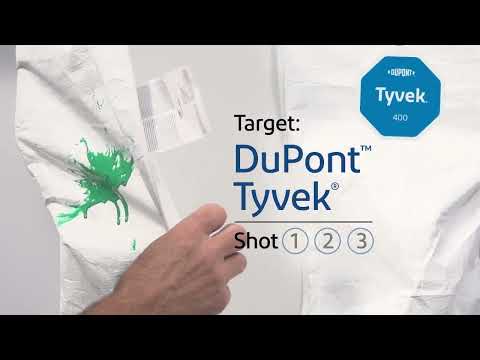How to Protect Yourself from Spray-Painting Hazards with DuPont’s Tyvek® PPE
DuPont’s Tyvek® coveralls protect professional painters from exposure to harmful airborne liquids and solid aerosols that can penetrate the skin.
DuPont’s Tyvek® coveralls protect professional painters from exposure to harmful airborne liquids and solid aerosols that can penetrate the skin.
The invention of spraying machines in the late 1800s transformed commercial painting, boosting productivity in industries from shipbuilding to construction and railways. It also created new risks for workers.
More than a century later, regulators are still identifying some of the hazards, and safety equipment producers such as DuPont are devising increasingly effective tools, such as Tyvek® coveralls and garments, to counter them.
“The principal hazards associated with the spray application of paints and other coatings are related to the components in the paint or coating, as well as the application process itself,” the Wilmington, Delaware-based company says in a pamphlet.
The U.S. Occupational Safety and Health Administration, the top workplace safety regulator, addresses those hazards in a variety of regulations, some tailored to specific industries such as construction and shipbuilding.
“During spray-painting operations, workers are at a greater risk of exposure to hazardous substances than when they are painting with a brush or roller,” the agency explains in a pamphlet on risks to ship painters.
Spray nozzles propel paint particles into the air, heightening the release of hazardous vapors, OSHA says, and the work is often done in confined spaces that, if not correctly ventilated, “can cause sickness or death for workers.”
Depending on the environment and the job, the agency requires both respirators to protect painters’ airways and coveralls to protect their skin from contact with toxins.
For less sprawling operations such as applying paints and coatings to boats and small watercraft, spray booths are typically used, both to curb fire risk and limit exposure, since the mix of solvents, pigments and additives in coatings can cause harm by either inhalation or skin contact.
In an effective spray booth, painters typically encounter only small airborne liquid drops or solid aerosols that range from 0.5 microns to larger than 10 microns, depending on the equipment used, DuPont says. A micron is one-millionth of a meter.

At those sizes, aerosol solids and liquids have similar skin-penetrating capabilities.
Tyvek® coveralls have become popular safety gear for painters, DuPont says, because they provide a high degree of protection from airborne particles and many water-based inorganic chemicals but are also resistant to abrasion and tears, which can come from leaning on rough surfaces like metal, concrete and wood to reach inconveniently situated parts of a workpiece.
Abrasion resistance benefits the work as well as the worker: It means the material is less likely to generate lint particles that can mar the smooth finish customers expect.
In the auto industry, that helps avoid so-called cratering on automobile exteriors—pinhole-shaped indentations in paint caused by contaminants from fabric to human hair and skin, DuPont says.
Tyvek® consists of ultra-fine, high-density polyethylene fibers that are compressed under high heat and pressure to form a nonwoven material that provides a multilayer barrier, one that can remain intact even if the outer layers are damaged in places, according to the company.
Lightweight and soft, the material is also permeable to air and water vapor, making it more comfortable—a key benefit since many painters contend with significant heat stress.

Their work environments are often indoors, enclosed with heat-generating machinery. Those who work outdoors typically do so during the high-temperature summer months.
While Tyvek® 400 is a popular all-purpose choice for protecting the head and body, painters encountering mostly forward-facing spray exposure may opt for Tyvek® 400 D, a dual design with Tyvek® fabric on the front and hood and more breathable ProShield® 10 fabric on the rear, the company says.
Tyvek® 600 and 800 options, which both come with an attached hood designed to fit around a respirator, offer increased protection against water-based inorganic chemicals, according to DuPont.
Ultimately, choosing the best protective clothing and gloves for a particular job depends on a variety of factors, including the type of paint or surface coating used, the concentration of chemicals involved and the type of application.
Prospective buyers uncertain about what they need can get help from DuPont’s SafeSPEC™, a web-based tool designed to assist with selection.




